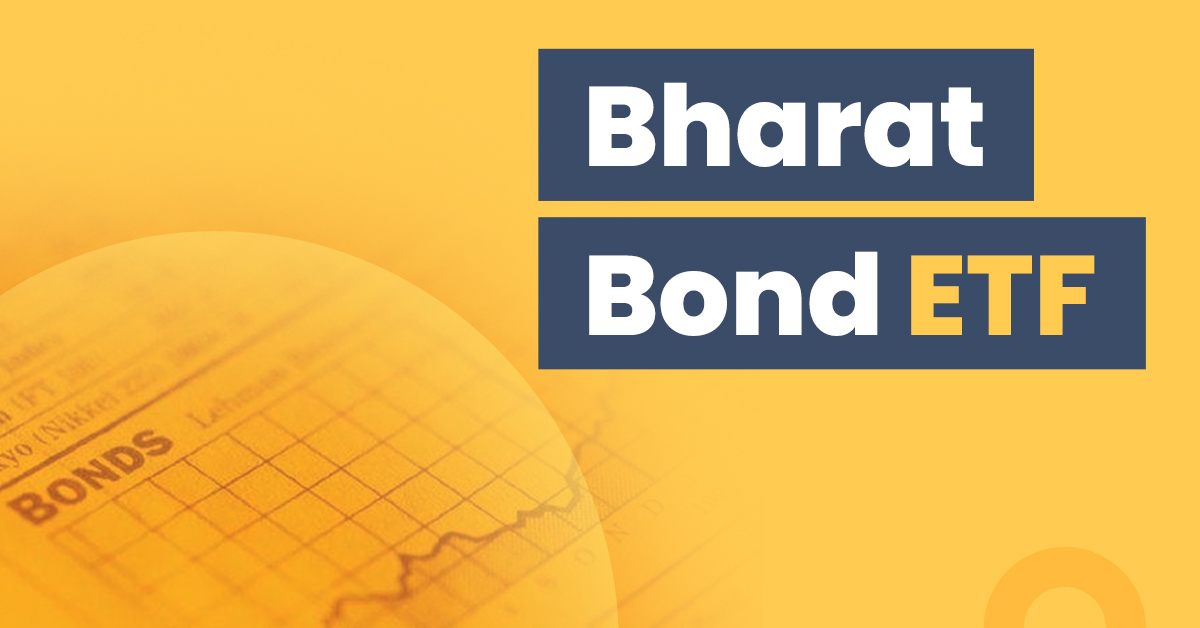Bharat Bond ETF: Meaning, Benefits, Risks & Taxation


India had an underwhelming bond market for a long time. Even though there was a great demand for debt instruments, several supply-side and regulatory bottlenecks were affecting its development.
The Indian government, in order to strengthen the bond arena, introduced a new offering for investors. It is the Bharat bond ETF which invests in bonds issued by India’s public sector undertakings. Let’s discuss the various functioning aspects of this bond category!
What Are Bharat Bond ETFs?
Bharat bond exchange-traded funds (ETF) represent a basket of bonds issued by various public sector undertakings like NABARD, Indian Oil Corporation, Power Finance Corporation, etc. The minimum investment amount in these bonds is ₹ 1,000, which allows small retail investors to be a part of this initiative.
The underlying bonds of these ETFs come with a fixed maturity date. Since its inception in 2019, these bond ETFs come in a series of two tenures – three years and 10 years. Each of these series follows a distinct index which is formulated by the National Stock Exchange of India.
Now that you are well aware of the meaning of Bharat bond ETF let’s jump to its other aspects.
How Do Bharat Bond ETFs Work?
These are debt funds which follow a passive investment strategy. These exchange-traded funds replicate or follow a particular benchmark index and hold underlying bonds till maturity of the bond. The index that the Bharat bond exchange-traded funds replicate is the Nifty Bharat Bond Index.
This strategy is different from active debt funds wherein the respective fund managers play an active role in determining the portfolio and carrying out changes as per their strategies. In the case of Bharat Bond ETF, there is no active management of bonds. Issuing bonds under this category helps India’s fund-starved public sector entities to raise funds and, at the same time, give a fillip to India’s capital market.
Let’s see the various constituents of the Nifty Bharat Bond Index April 2032:
| Issuer | Ratings | Weightage |
| Indian Railways Finance Corporation Limited | AAA | 15% |
| Power Finance Corporation Limited | AAA | 15% |
| Power Grid Corporation of India Limited | AAA | 15% |
| NTPC Limited | AAA | 15% |
| National Bank for Agriculture and Rural Development | AAA | 14.98% |
| Export-Import Bank of India | AAA | 12.15% |
| National Hydro Power Corporation Limited | AAA | 8.72% |
| Nuclear Power Corporation of India Limited | AAA | 4.15% |
| Total | 100% |
The constituents will change only under two conditions. One is when the respective public sector units will undergo privatisation, and the other is when a company faces a rating downgrade. In either situation, debt instruments having the same maturity as other public sector units will replace them.
How to Invest in Bharat Bond ETFs?
Here are the steps that you can follow to invest in these funds:
Step 1: Determine whether you wish to invest for the short term or long term. Short term ETFs have a maturity period ranging between 3-5 years, and long term bonds come with a maturity period of 10 years.
Step 2: Visit the official portal or branch office of the registered fund house that is offering these bond ETFs.
Step 3: Complete all the registration and KYC formalities and upload relevant documents to open your Demat account.
Step 4: link your bank account with the Demat account and transfer the requisite funds.
After completing all the above steps, you can easily buy and sell units of Bharat bond ETFs.
What Are the Benefits of Investing in Bharat Bond ETFs?
Some benefits of investing in these exchange-traded funds are as follows:
- The major benefit of Bharat Bond ETFs are its stable and predictable returns along with safety as the underlying bonds are highly rated public sector entities. These ETFs are closed ended funds which means the maturity is fixed and hence an investor can predict the returns on the investment if held till maturity. Therefore, it can be a relatively safe bet for you if you are a conservative investor.
- Investing in Bharat bonds ETFs is a cost-effective method of investing in India’s public sector units which has a great potential for growth.
- Another major benefit of investing in these debt funds is their high level of liquidity. The units of these funds are eligible for trading on various bourses. Therefore, you can easily buy or sell your units.
- These funds are subject to heavy scrutiny by the Securities and Exchange Board of India, which mandates the highest norms of transparency from fund houses and managers. Hence, you can easily see all the available information and take appropriate action.
- Another important component of these funds is the tax efficiency that it comes with. Investing in these funds will lead to better tax management.
What Are the Risks of Bharat Bond ETF?
The risks associated with this investment are as follows:
- Credit Risk
Investing in any debt instrument always involves credit risk, i.e. the risk of default. In case the bond is secured by a collateral, the money can be recovered by selling the same.
- Liquidity Risk
Although the units of these funds are tradable on several stock exchanges, there has to be a buyer or seller to complete a transaction. If you wish to exit these funds, but there are no buyers for the same, it can lead to a distressed sale. Therefore, you will be at risk of incurring significant losses.
- Interest Rate Risk
One of the main components in the functioning of bonds is interest rate. If interest rates rise, it will lead to a fall in bond prices thus having a negative effect on the return. The opposite will happen in case there’s a fall in interest rates.
Therefore, if you plan to go for a premature exit, you might have to face several fluctuations in bond interest rates.
Taxation of Bharat Bond ETFs
The capital gains accrued from selling units of these funds are subject to taxation as per the holding period of the units.
If the holding period of the ETF units is less than 36 months, the gains are considered short term capital gains (STCG). STCG tax is your applicable tax slab rate.
On the other hand, if the holding period of the units is 36 months or more, the gains come under long term capital gains. LTCG tax rate is 20% with indexation benefits, excluding surcharge.
Final word
Bharat bond ETFs are a kind of debt fund that invests in bonds issued by India’s leading PSUs. As is the nature of an ETF, it replicates an underlying index. This is a kind of debt fund, and if you are planning to invest in them, you should consider your investment goals and risk appetite before making any decision.
Frequently Asked Questions
Who can buy Bharat bonds that are based on ETFs?
All resident Indians, as well as non-resident Indians, are eligible to invest in these funds. Additionally, non-individual entities can also take part in the investment process. The only requirement for investment is having a Demat account. One can also invest in the ETF even without a Demat account through a fund of funds (FoF).
What are the objectives behind introducing Bharat bond ETFs?
Some reasons why the Indian government introduced this category of bonds include increasing participation of retail investors, having a more diversified source of funding and easy availability of capital for India’s PSUs.
What is the minimum investment amount of Bharat bond ETFs?
As per the regulations of the Securities and Exchange Board of India, the minimum investment amount in these funds for retail investors is ₹ 1,000. The maximum amount that a retail investor can put in this fund is ₹ 2,00,000 in the NFO.
Do Bharat bond ETFs come with a lock-in period?
No, ETF-based Bharat bonds do not come with a lock-in period. You are free to sell and exit your holdings before the end of fund tenure.




